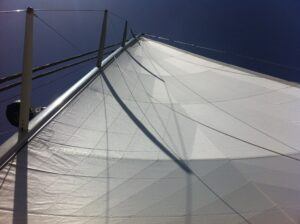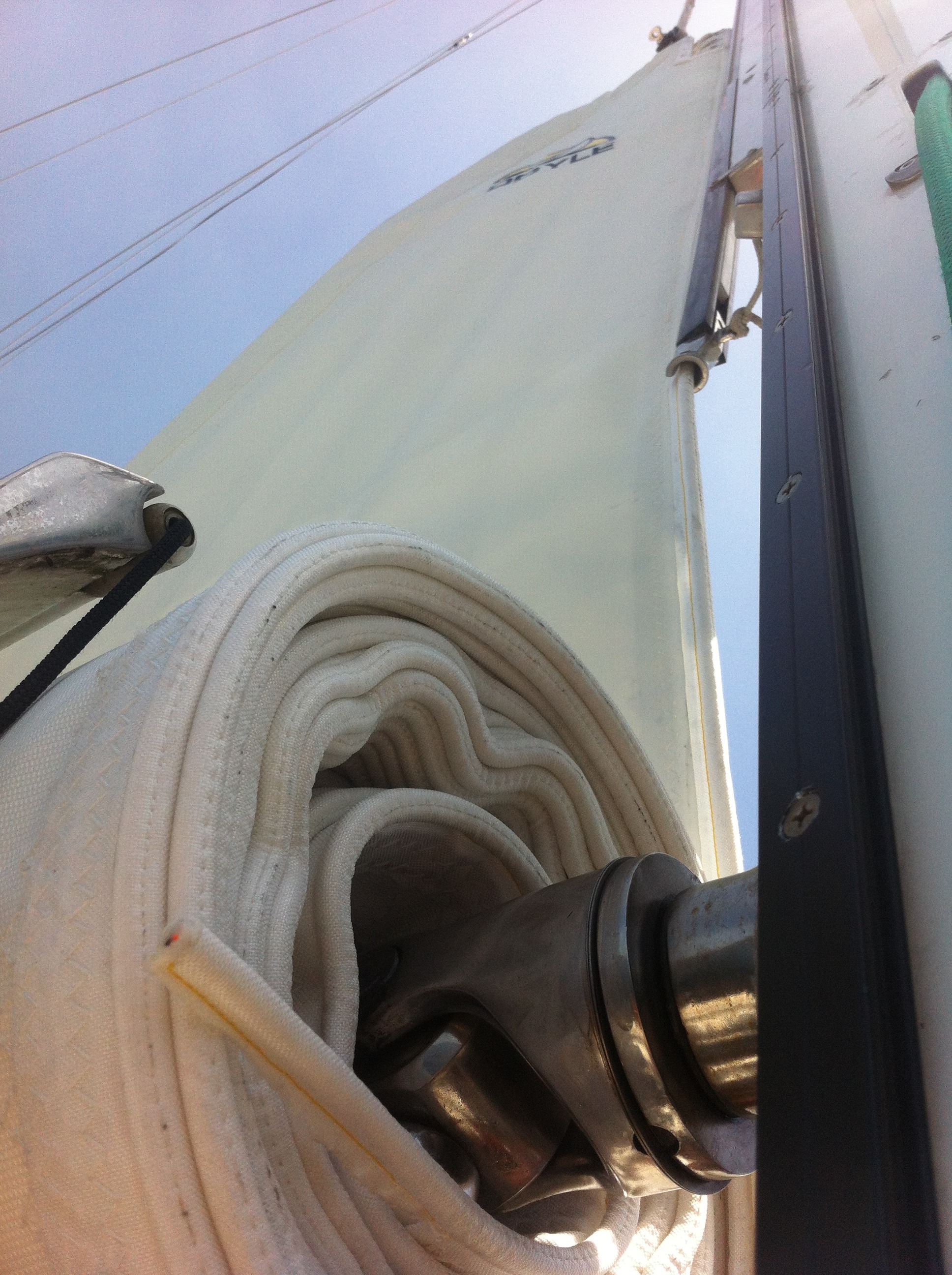
There are 3 systems for mainsail handling. We looked at the pros and cons of In Mast Furling mainsails. Now we will look at another option, In Boom Furling for the mainsail. These methods came about from efforts to make conventional mainsail handling easier. Let’s see how they work.
Conventional Mainsail
Every sailor is familiar with the mainsail and the conventional way of dealing with it when we go sailing. It is stored on the boom in some sort of cover. We hoist it up when we go sailing, take it down when we are finished and cover it back up. Reefing it while sailing is a job for all hands as well. There have to be easier ways to do this. Right?
We looked at In Mast Furling where the sail is hoisted then furled away into the mast. To go sailing one just unfurls it and furls it back in when finished. No covers necessary as it is protected from the elements inside of the mast. Let’s now look at another method, the In Boom Furling system.
In Boom Furling Mainsail | Pros
As the name suggests, this system works where the Foot of the sail is attached to a furling mechanism in the Boom. It unfurls as you hoist it and furls in as it is lowered. For ease of handling it is slightly more complex than In Mast furling but still lots easier than using a conventional mainsail.
An advantage it has over In Mast furling is that the sail can have battens. Therefor the mainsail can have some Roach and have a bit more area than one used with In Mast furling. For those to whom performance matters a lot, this is a big plus. You will still have ease of handling without much loss in sailing performance.
Another advantage is that if, or when things go wrong with the furling system, you can still get the sail down. With In Mast furling, if there is a furling problem it’s normally much more serious. If the furling gear gets stuck and the sail is not all the way out, then you can’t get it down by simply releasing the halyard. Drastic measures are necessary often involving going aloft and/or sharp knives.
Sail covers are also not needed with this system. Except to cover the top of the boom. Not needed are the big sail covers and lazy jack systems needed with conventional mainsails.
Cons
As with all things boat related, there has to be compromise. One thing, this ease of handling comes at a cost. You have to have a special boom and it is not possible to retrofit your standard boom. Most times it is also not possible to retrofit your old mainsail as well. The sail has to furl neatly so cannot have heavy reef and corner patches or reinforced batten pockets or hardware. It also has to have a special Luff tape. These are big items and all add up in cost.
Another big issue is Reefing. Although, theoretically this is an advantage over conventional slab reefing mainsails. In reality, it’s not. This system is supposed to give you the option to put in any sized Reef that you want. In reality, you have to reef to the battens.
Unlike with a conventional reefed main, there is no out haul line at the back of the boom. When you reef, there is nothing to pull the Leech end tight and keep the sail flat. The sail “tightens up” on the furling mandrel and the Leech “moves” forward. This causes the sail to get fuller. Not what you want when you are reefing to depower the sail. This can be somewhat alleviated by reefing to the battens. By keeping the battens alongside the mandrel, the Foot is kept tight.
Another issue with the full battens is that the Roach “pushes” them forward into the Luff tape and foil. This in turn causes wear on the Luff tape. This is the most common repair in the sail loft with In Boom mainsails. Replacing the Luff tape.
Final Thoughts
So, which is the best system for you? For ease of handling ability to get sailing easily, the In Mast Furler. Closely followed by the In Boom Furling system with the conventional mainsail system after that. For the ability to deal with problems when they happen. The conventional system followed by In Boom and then In Mast last.
Sailing Performance. Conventional main then In Boom Main then In Mast mainsail system.
Cost. This is the big one. If you are just looking to buy a boat with whichever system you prefer then it’s not a problem. However, if you are thinking of retrofitting to an existing boat then there are costs involved. To change to or from In Mast furling is going to involve a new mast so we will ignore that for now.
If you have a conventional rigged boat and thinking of changing to In Boom furling then the costs add up. You would have to factor in the price of a new boom, Vang and the whole system, and a new mainsail.
On the other side, you could up grade your conventional rigged boat to make sail handling easier. Using a track system to make hoisting easier. A lazy bag system for dropping the sail for example. But that will be for another blog. For now, everything in boating is a compromise depending on what your preferences are and what kind of sailing you plan on doing. No one answer is correct for everyone as we are all different. If anyone needs further information please feel free to contact me below.

